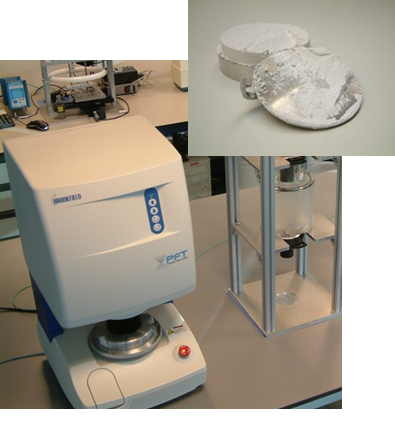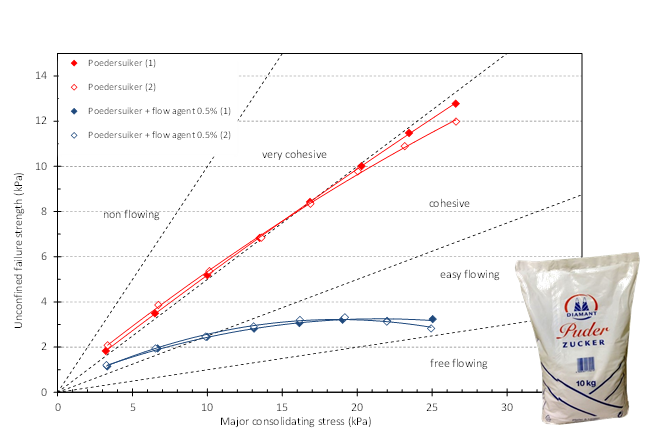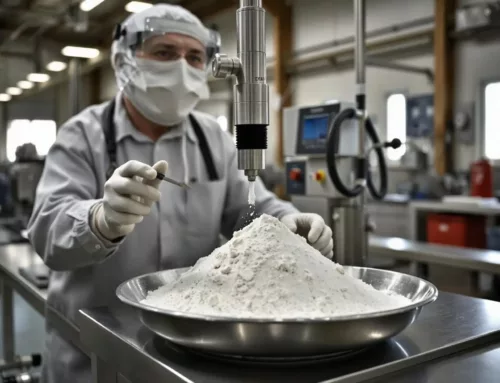
In this article, we will cover Bulk Powder Characterization for Silo design, looking at the various phenomena that need to be taken into account. Flow properties in silos depend on both environmental conditions and powder characteristics. Particle size is a crucial factor. For instance, in a single silo, aluminum oxide particles of 100 micrometers flow easily, while 50-micrometer alumina particles tend to form a bridge at the outlet, stalling the outflow. Smaller particles exhibit greater cohesion, reducing flowability. Adding a “flowing agent,” an inert fine powder, can improve flow by acting as a lubricant, distributing particles more evenly. A small percentage of this agent often significantly enhances flow behavior.
Bulk Powder Characterization for Silo design optimizing Flow Function
Quantitative mapping of flow behavior can predict performance using a shear stress test, which measures friction under different pressures similar to those in silos. These measurements allow the creation of a flow function. Chart 1, for example, shows powdered sugar’s flow function. In its pure form, powdered sugar is highly cohesive, but adding a flowing agent greatly improves its flowability. This transformed powder behaves very differently in a silo, making it much easier to handle.
Silo Design Considerations
Optimal silo design starts by considering the storage material’s properties, including bulk density and wall friction. Based on this analysis, the silo’s geometry, construction material (polymer, steel, or aluminum), outlet size, and hopper angle are customized for smooth flow. Engineers use these techniques to design new silos or solve flow issues in existing systems. By adapting the silo’s design to the material, manufacturers can ensure consistent performance.
Segregation Challenges
egregation can occur when powders are stored or transferred, affecting quality. Large and small particles, along with those differing in density or shape, behave differently during movement, leading to segregation. Free-flowing powders are especially prone to this issue. Techniques like fluidization (introducing air at the bottom of the powder container) and sifting (controlled release from a hopper) help identify how prone a product is to different types of segregation. Early intervention in mixture formulation can reduce segregation risks. If necessary, liquid additives may be added to enhance cohesion and prevent particle separation.
Bulk Powder Characterization for Silo design – Wear and Attrition of Bulk Powder
Particles experience various forces during processing, leading to potential wear or shape changes. Sharp edges may break (attrition), or particles might round out or degrade from scraping against silo walls (abrasion). This wear affects particle shape and size, which influences flow. While several tools are available for testing the breakage of larger particles, few methods exist for smaller particles under 5 mm. Delft Solids Solutions in Wateringen has developed a Robotic Compression Tester that assesses elastic and plastic deformation and measures hardness in small particles. Additionally, they use Bulk Crushing Strength techniques to simulate and measure wear behavior under different conditions, helping predict how particles will change over time.


Dustiness of Particles
Wear on particles often generates dust, an undesirable byproduct that can pose health and environmental risks. To assess dustiness, European standards recommend specific testing methods. Specialized filters capture dust, measuring the inhalable, thoracic, and respirable fractions to assess health risks. Tests occur in rotating drums, simulating product handling, or through controlled drops that mimic product release, allowing for a realistic evaluation of airborne dust generation.




